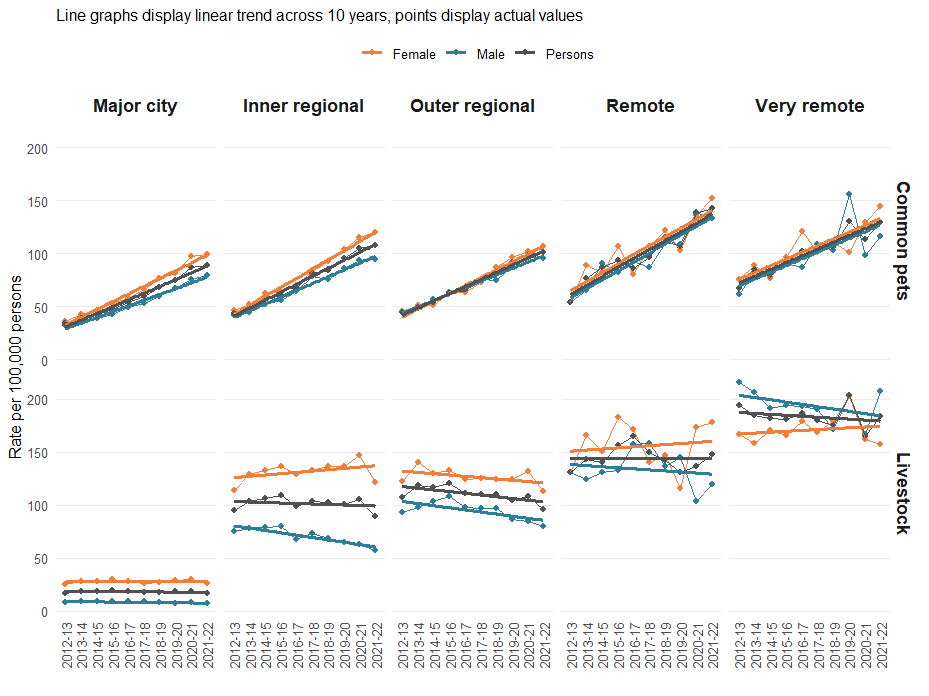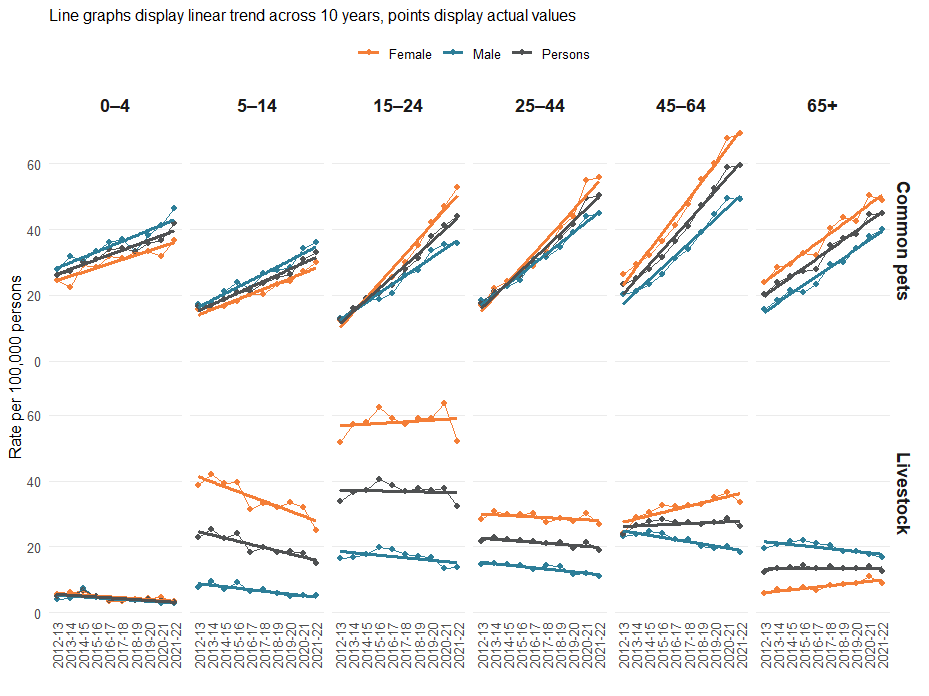Common pets
This report counts cats and dogs as common pets. Over two thirds of Australian households are estimated to own a pet, so unsurprisingly common domestic pets constitute the largest proportion of animals involved in injury hospitalisations. The following groups have increased exposure to common pets (Animal Medicines Australia and Newgate Research 2022):
- women (nearly 2 in 3 pet owners are women)
- families with children (three quarters of those with children aged above 5 years and 4 out of 5 with children aged 12-17 years have pets)
- 18-24 years old (7 out of 10 have pets)
- 40-54 years old (two thirds have pets).
Two thirds of pet-related injury hospitalisations occurred from major cities (Figure 10). The rate of pet related injuries has increased over the past decade across all regions.
Figure 10: Trends in crude rates of injury hospitalisations related to domestic animals by region, Australia, 2012-22

Source: National Hospital Morbidity Database
Over half of injury hospitalisations during 2021-22 where pets were involved occurred in females (Figure 11). The age groups most frequently hospitalised were 25–64-year-olds. 0–4-year-olds hospitalised for injuries from contact with animals were most likely to have been injured by a pet, with rates of injury from common pets in this age group increasing over the decade.
Figure 11: Trends in rates of injury hospitalisations related to domestic animals by age group, Australia, 2012-22

Source: National Hospital Morbidity Database
Dogs
Approximately 40% of Australian households have a dog, equating to about 5.1 million dogs (Animal Medicines Australia and Newgate Research 2022). While being bitten or struck by a dog was the most common cause of hospitalisation due to contact with animals, these injuries represented under 2% of all Australian injury hospitalisations during 2021-22. Adults aged 25-44 and 45-64 made up the majority of injury hospitalisations due to being bitten or struck by a dog (29% and 28% respectively). While only 6% of injury hospitalisations due to contact with a dog were for children aged 0-4, over half (61%) of all injury hospitalisations due to contact with animals for this age group were due to being bitten or struck by a dog.
Figure 12: Summary statistics about 9,542 injury hospitalisations related to dogs during 2021-22

-
There were 37 cases per 100,000 people in Australia, 4 in 5 injuries were open wound (7,681 cases)
-
1 in 4 injuries (2,384 cases) occurred in homes
-
Where activity was recorded, leisure contributed to about 2 in 5 injuries (551 cases)
-
Nearly half (4,323 cases) injured their wrist or hand.
-
Nearly 1 in 5 (1,987 cases) sustained a head and neck injury
-
Place and activity detail were often unrecorded:
- place of occurrence in 6,221 cases
- activity in 8,156 cases
For more information please refer to supplementary data tables 4 and 5.
Trends
As expected with increased exposure to pets, numbers and rates of injury hospitalisations due to contact with dogs increased since 2012-13. Age and sex differences are outlined in Figure 13, with the highest rates in males being aged under 5 and in females aged 45-64. Across sexes and years, 0–4-year-olds were at relatively higher risk of these injuries as compared to other children or most adults.
Figure 13: Heatmap of crude rates per 100,000 persons of injury hospitalisations due to contact with dogs by age and sex, Australia, 2012-22
Source: National Hospital Morbidity Database
Animal Medicines Australia and Newgate Research (2022). Pets in Australia: A national survey of pets and people: 1-50


